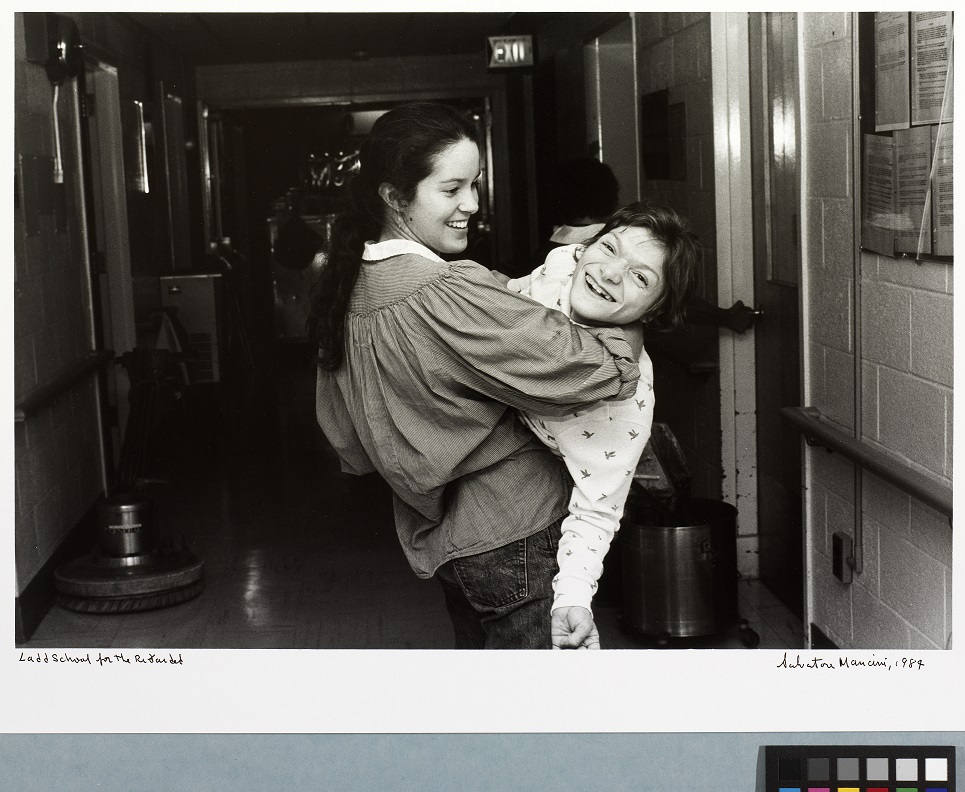
“Ladd School for the Retarded (woman holding young girl),” by Salvatore Mancini, 1984. From Darkness, Days of Hope: The Deinstitutionalization of the Institute for Mental Health and the Ladd School, 1984. Gift of Dr. and Mrs. Joseph A. Chazan 2001.39.21. RISD Museum.
She seems so happy. Both of them do, actually. They look like any two schoolgirls, having a laugh in the hallway.
But that’s not just any school.
The young girl in this photograph was a member of the Ladd School for the Retarded in the 1980s. She was mentally handicapped in some way, though we don’t know her name or her full story. She represents a history of young girls with mental or physical disabilities whose stories go back thousands of years, yet remain silent and hidden.
The first mention of intellectual disabilities dates to 1552 BCE, when the Egyptians noted that they left babies born with severe disabilities to die of exposure. Throughout the centuries, disabilities were never defined or classified, so treatment and determination was varied. It wasn’t until 1799 that people began advocating for skills-based programs to help teach the “feeble minded” (as they were called by Jean-Marc Itard). During the 1800s, optimism generally prevailed, with many believing the disabled could be rehabilitated for normal life. Yet this rehabilitation meant silence, with treatment occurring in asylums, poorhouses, and country houses where they were further isolated from society.
By the time of the Ladd School, this optimism had waned. The “feeble minded” were increasingly blamed for poverty, illness, and crime, and their traits were considered heritable. The eugenics movement advocated that they be sterilized, and institutionalized life became the norm. It’s worth noting that even during the 1800s, the definitions continued to vary widely – and girls could be classified as insane or feeble minded for a variety of things (including simply because their male relatives said so). It wasn’t until the 1960s that these practices were disproved by modern science and advocacy groups helped increase human rights for the intellectually disabled.
The Ladd School is typical of twentieth century disability history. Begun in 1908, it was run as a state institution for the mentally retarded or developmentally delayed until 1993. When this photograph was taken in 1983, the school was already waning. The 1970s had seen scandals centered around horrible living conditions and health and human rights violations (including several patient deaths). Though the lawsuits had settled and the school revised its policies, its population dwindled. The deinstitutionalization movement (which replaced psychiatric hospitals with community mental health services) resulted in the school closing in 1993.
Though we have no idea of the full story behind this young girl’s seeming smile, she represents one of the estimated 5.6 to 6.7 million people who were classified as mentally retarded in the 1980 census. She had a life, and probably had various hopes and dreams. Did she love art, books, or music? What was her favorite flower? Did she visit family, or was she institutionalized all her life? What unique gifts did she bring to the world? What’s her story?
I wish I could ask her.
-Tiffany Rhoades
Program Developer
Girl Museum Inc.
Today, the Ladd School is remembered in a small virtual museum. Yet the building itself, long rumored to be haunted, was demolished in 2012. A memorial stands on the site of the original farmhouse, surrounded by disintegrating roads.
This post is part of our 52 Objects in the History of Girlhood exhibition. Each week during 2017, we explore a historical object and its relation to girls’ history. Stay tuned to discover the incredible history of girls, and be sure to visit the complete exhibition to discover the integral role girls have played since the dawn of time.
